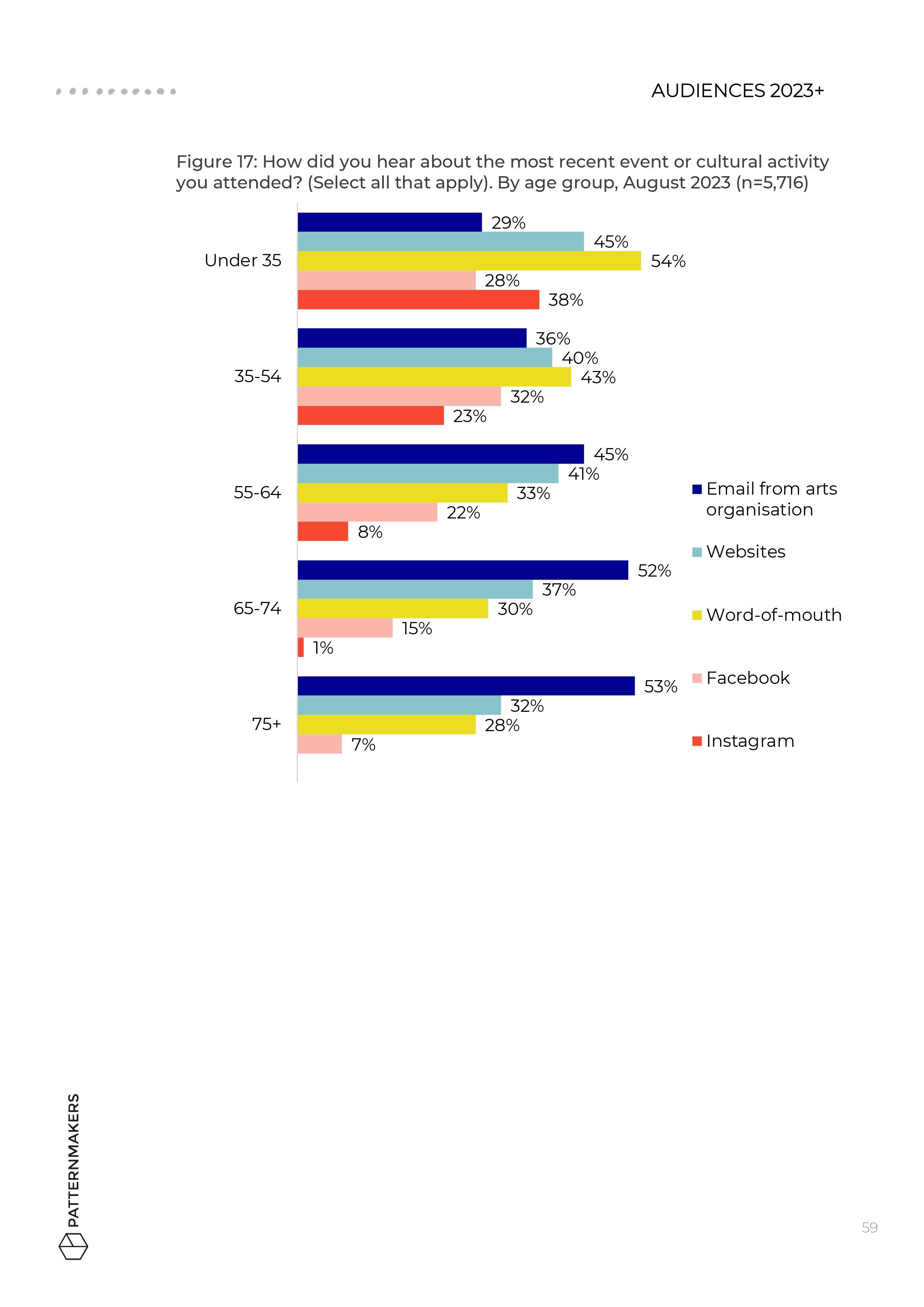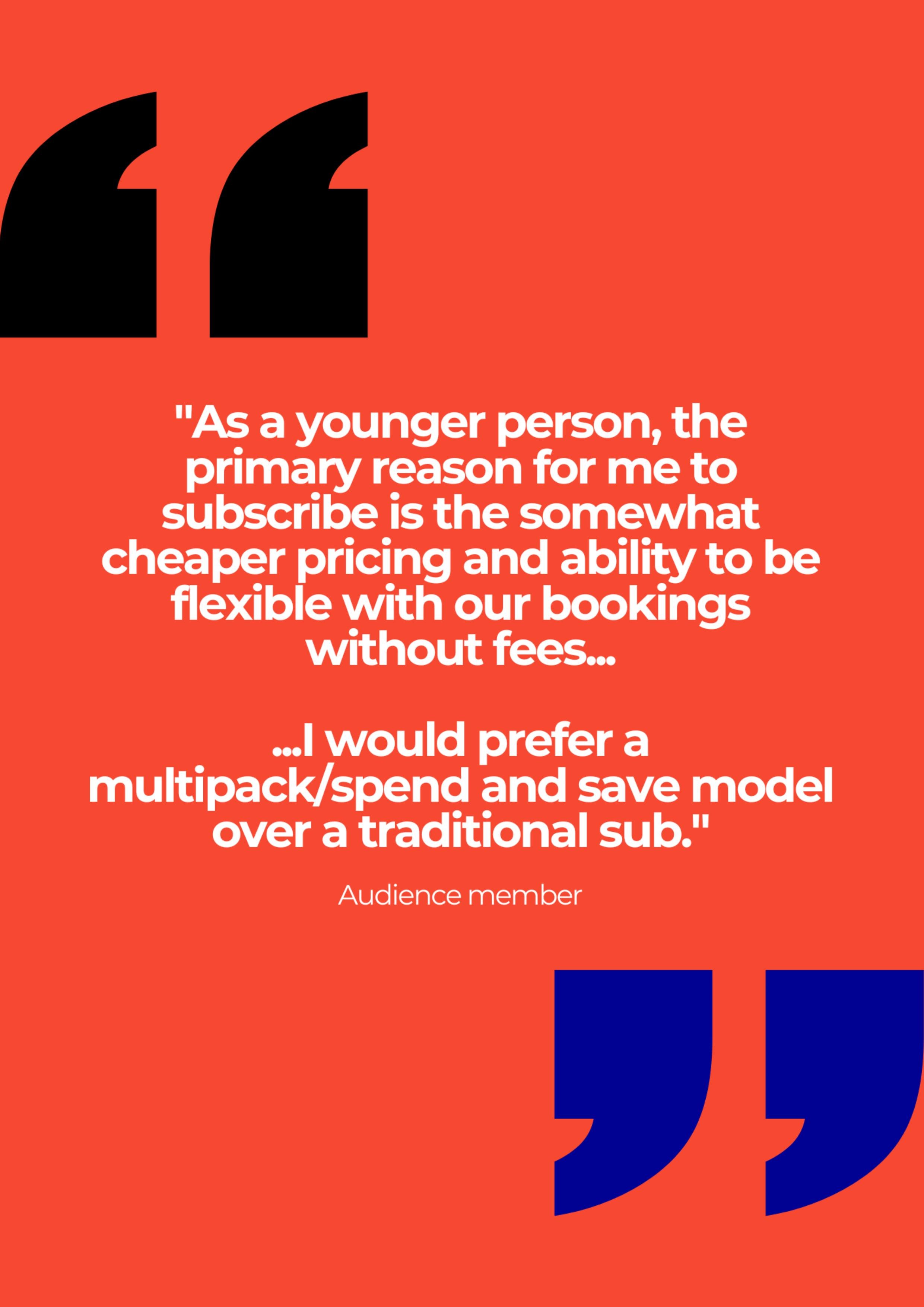The top trends shaping Australian audiences in 2023 and beyond
1. Attendance trajectories
Attendance rates across the country continue their slow recovery since the pandemic, and with a challenging year ahead, it’s wise to set sights on the right targets.
-
In 2023, attendance is reaching its highest point since 2020, and the frequency of attendance is increasing, but the recovery process continues.
Strategic investment and programming shifts have helped many organisations sustain or increase their capacity in 2022 and 2023, but charting recovery is complex, with mixed attendance results across the market.
Big jumps in attendance appear unlikely in the next 12 months, with 2 in 3 audience members expecting their attendance levels will stay the same amid a challenging economic outlook.
Making space to review measures of success and share learnings – internally and externally – may help organisations focus on the right challenges over the coming year.
Click the buttons below to download the August 2023 Snapshot Report, as a PDF, accessible Word version or RTF, or read on for more of the findings.


















































































2. Inflationary pressures and pricing
Economic conditions are limiting what Australian audiences can spend on events, and some segments need targeted thinking to ensure access to arts and culture.
-
Financial reasons are the top barrier to attendance, and inflationary pressures are expected to continue in 2023 and 2024.
Spending levels at arts and culture events are not growing, as audiences weigh up value for money and take longer to make decisions.
Younger audiences and families continue to be the most impacted.
A key opportunity is developing sustainable strategies for targeting disadvantaged segments.
3. The desire to inspire
In the wake of the pandemic, audiences are in the mood for uplifting experiences — requiring event organisers to think strategically about creating meaning and building trust in difficult times.
-
Australian audiences are showing significant appetite for a wide range of content, though budget pressures are leading some audiences towards ‘safer’ bets or ‘guaranteed fun’.
Social, uplifting experiences and events with great reviews will continue to reach the widest audience in the coming year.
Many audiences are hungry for meaning, but care and tact may be needed to when approaching challenging topics.
Organisations that understand the mood can please crowds today while building trust for tomorrow.
“The arts are so important to keeping my spirits up and my mental health well.
It’s really challenging when you can’t afford to go to an event every now and again that you know will keep you well.”
4. Three segments to know
Younger audiences, families and older audiences are thinking and behaving very differently in 2023, and organisations must build capacity for new ways of working.
-
Social and economic pressures impact different generations in different ways, and this is reflected in three key audience segments.
Young people, families and older audiences show stark differences in mood, entertainment priorities, spending patterns and media consumption.
Organisations must consider how to create and execute strategies for different segments and build in flexibility to adapt as conditions evolve.
For easy viewing, click below to download the summary of all three key segments.
5. Online trends
Audiences continue engaging online in large numbers, and in 2023, online content is helping audiences find out about events, discover new artists and participate in digital experiences.
-
Digital channels are paramount to audience engagement – with 75% of recent attendees finding out about arts and culture events online.
Preferred platforms look very different across age groups: email marketing is the priority for 55+, while word-of-mouth and socials are key for under 35s.
4 in 10 audiences continue to engage in online arts and culture, and half say digital cultural activities still play a role in their lives, despite spending less.
It might be time to review online offerings, scrapping what's not working and freeing up resources for more targeted approaches.
“Australian arts audiences are intelligent and open to be challenged...
...This is essential for the future health and development of arts in this country.”
6. Late decision-making
In 2023, last-minute decision making persists, with audiences facing more choices, and busier lives, as commuting, travel and social events pick up. Organisations need to prepare for new phases in campaigns, to reach people at the right time.
-
Half are booking less than two weeks out, with 12% on the day of the event
Analysis of ‘early bookers’, ‘mid-term bookers’ and ‘last-minute bookers’ shows that last-minute ticket buying is most common among younger audiences and lower spenders. Those booking later are also more likely to rely on word-of- mouth.
Ticketing initiatives to support more price sensitive audiences are important, but last- minute discounting may not be the answer.
7. Subscriptions and memberships
Subscribers and members are vital for many arts organisations, but their needs vary dramatically across age groups, and organisations are adjusting their packages to suit new needs.
-
4 in 10 audiences are members or subscribers– with performing arts subscriptions more common than other types.
Subscriptions uptake and motivations are very different across audiences in different stages of life.
Older audiences want to lock their plans in early and show financial support, while younger audiences are more likely to want access to discounted tickets.
There is a case to test different offers and models, using messaging to target the unique needs of different audience segments.
Cover Image Credit: Jacquie Manning, courtesy of Sydney Writers Festival.
Watch us launch the findings at APAX 2023
Our Managing Director, Tandi Palmer Williams, and Research Analyst, Peta Petrakis, travelled to Cairns to present the data from Audiences 2023+ at APAX 2023, PAC Australia’s annual conference.
Click the image below to watch the recording of the livestream. Simply register to make a free account and press play!
Use the dashboard to get results for your artform and region
Survey data from over 8,800 respondents has been uploaded to the dashboard, which now contains insights from over 100,000 Australian participants.
You can use the dashboard to explore the findings by state/territory, artform and audience segment.
It’s freely available to access, just click the image below and use the login details provided on the dashboard page.
About the Audience Outlook Monitor
The Audience Outlook Monitor provides the results of a study that has tracked audience sentiment over the course of the COVID-19 pandemic.
Data was collected in six phases throughout 2020-2022 and is again being tracked in 2023.
Government agencies across Australia are collaborating with research agencies Patternmakers (Sydney) and WolfBrown (USA) to produce this resource. The dashboard is freely accessible and designed to help artists and cultural organisations of all kinds to make the best possible decisions.
How to find out more
To receive new releases directly into your inbox, as soon as they are available, you can opt in to receive Audience Outlook Monitor news below.
Subscribers to our regular Culture Insight & Innovation Updates will need to update their preferences to receive all updates about the Audience Outlook Monitor. Just enter your email below and follow the instructions provided.
If you have a question, or an idea for using this data, please contact Patternmakers at info@thepatternmakers.com.au
Delivery partners
Supporting partners
Past posts on this blog
Archive
- 2023 21
- Dance 3
- Research 99
- Audience development 79
- Arts 73
- COVID-19 70
- Culture 72
- Data culture 69
- Evaluation 75
- Innovation 78
- Thought leadership 16
- About Patternmakers 35
- Privacy 6
- Project updates 25
- Culture Panel 1
- Resources 6
- Toolkit 5
- Beyond the Bio 8
- 2022 23
- Career Advice 9
- Opportunities 4
- Tips & Tricks 13
- 2021 7
- 2024 1
- First Nations 3
- Indigenous 2
- Strategic Planning 5
- Trends 3
- Performing Arts 5
- Manifesto 1
- Education 2
- Capacity building 3
- Digital art 4
- Interviews 3
- Coronavirus 2
- 2020 3
- Tandi Palmer Williams 7
- Theory of Creativity Podcast 1
- 2019 11
- Top 5 2
- 2018 12
- Case Studies 2
- Our services 4
- Postcode Analysis 1
- Accessibility 4
- Touring 3
- Publications 1
- 2017 8
- Data art 2
- 2016 5













